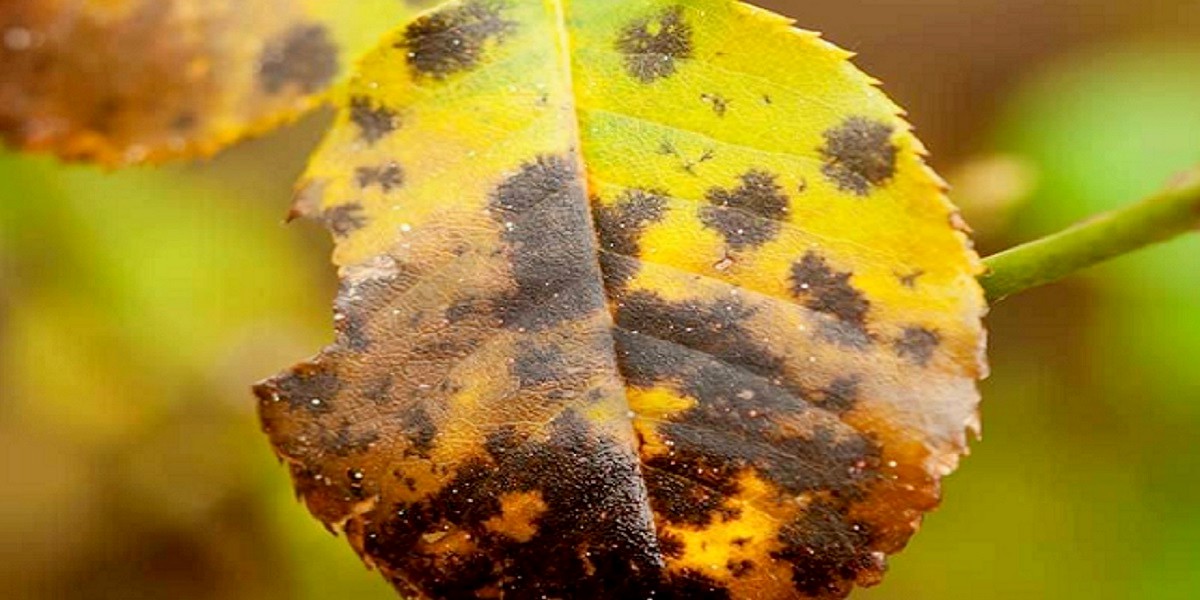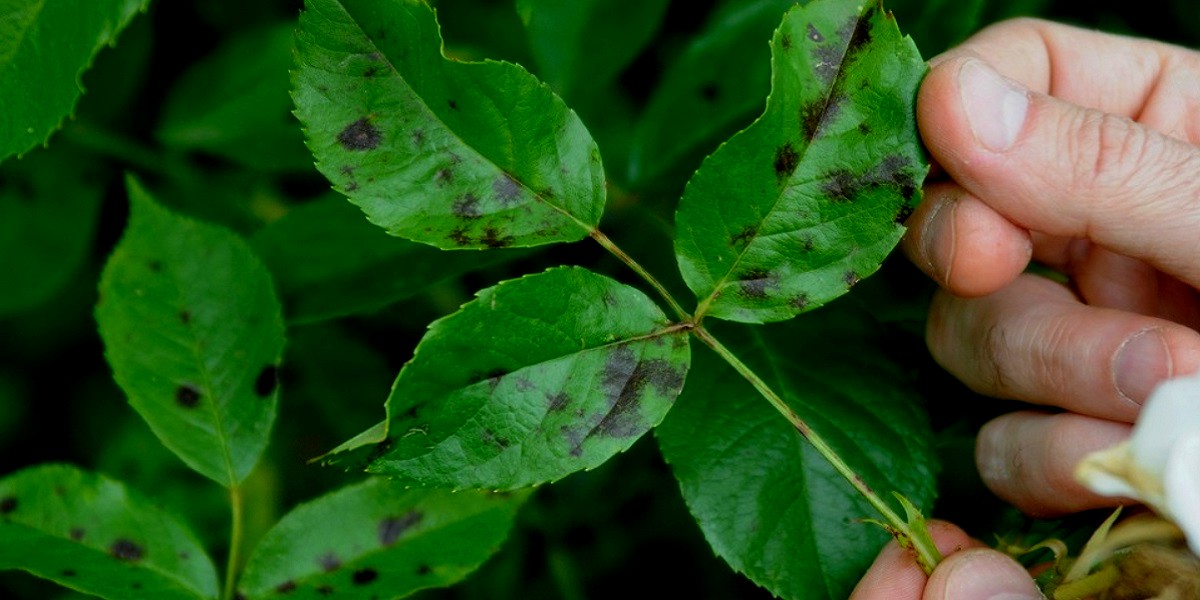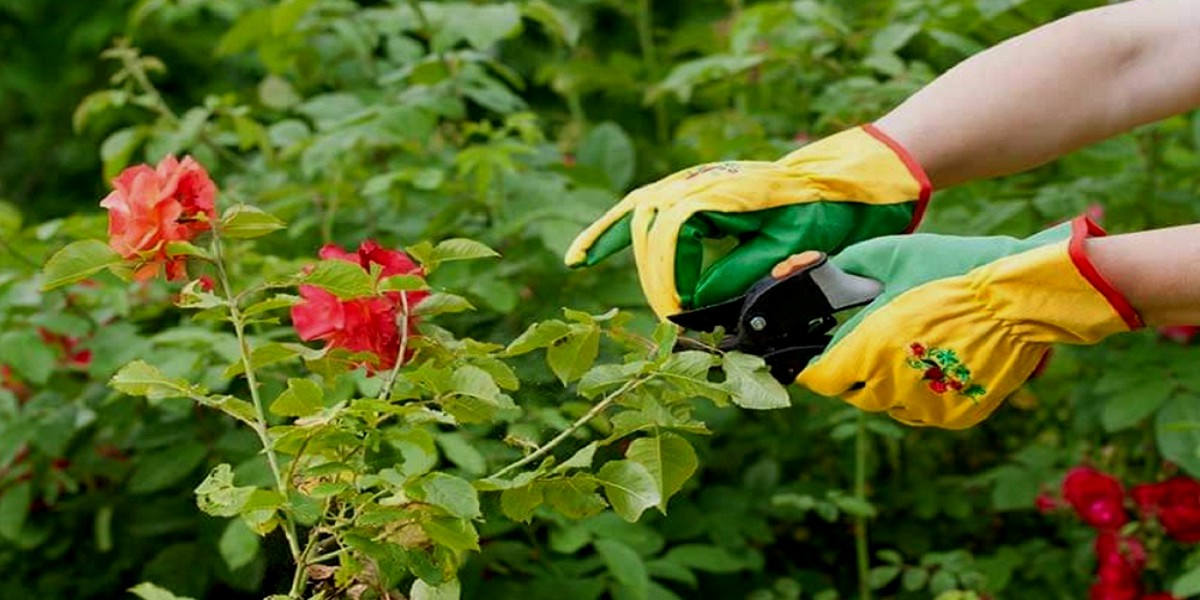Black spot on roses is a popular disease caused by fungi. It turns green leaves into yellowish covered with black spots. Once the disease progresses, roses can lose their leaves. Although this problem is caused by numerous factors and may even appear randomly on your roses, you can try to prevent it and stop its progress. If you are not sure whether you are dealing with rose black spot disease or something entirely else, you have to read this article and use a specific app to identify the illness. The app requires a photo and description of symptoms to find the disease.
Black Spot on Roses: Description
The name of the disease is the Rose Black Spot. It is caused by the fungus Diplocarpon rosae. This illness is widely spread among roses in the country and around the world. Infection usually appears during the Spring and early Summer. The fungus prefers damp air.
Rose bush black spots are recognizable. They can reach 0.5 inches in diameter at the beginning of the disease. The spots are round and dark black. Margins are fringed. As the disease progresses, the circles are getting bigger. Meanwhile, the color of the leaf is changing too. From the juicy green, it becomes yellow and drops down after some time. Moreover, the whole plant looks weaker and fragile. The disease affects blooms. While black spots do not kill rose by themselves, the plant is weak and loses immunity against winterkills and canker.

The disease is born in the spores. They are formed in acervuli, the fruiting structures. If there are no external factors, the disease may never appear. Yet, black spot diseases are transmitted to the roses with:
- Dew;
- Rain;
- Other diseased roses nearby;
- Sprinklers;
- Gardening tools that already contained spores from the other plant.
These spores get inside the tissue of the plant. They need up to 18 hours to infect the flower. The spots appear in 3-16 days, while new spores in 10-18 days. Once the new season starts the cycle can begin again. If you don’t use fungicide or don’t do any preventive measures, you may struggle with the same disease from the very beginning. Professional gardeners recommend removing the leaves once you notice black dots immediately. Don’t wait till the new spots appear in spring. Provide the treatment in advance.
Important detail! Pay attention to the fact that this fungus has numerous variations and a wide range of strains. It can mutate and become resistant not only to the local weather but to the treatment too. The knowledge of the process may save you from repeating the same procedure that stopped working. Like many plant diseases, this one can be tamed if you act immediately or even in advance. Even the new bred may not be resistant to the fungi.
Basic Symptoms of Black Spots on Roses
If you want to withstand the disease, you need to learn the symptoms in the first place. Unfortunately, rose plant diseases may look similar to root rot. Moreover, you may not notice the problem if you don’t know what to look for. Even basic symptoms may vary based on the types of roses you are dealing with.

Pay attention to the following changes:
- The first and the most important sign of the disease is big dark, usually black or purple spots that appear on the leaf surface. They cover the upper part of the leave, not the lower. If you notice big black spots on the lower part of the leaf, you have to look for other symptoms of different diseases. Make sure that the spots look round, not prolonged and asymmetric;
- The tissue of the leaf turns yellow once the disease cycle moves. At first, the yellow color can become visible near the black spots. After that, it consumes the whole leaf. Black spots usually stop the photosynthesis process and leaves can no longer feed on the sunlight and stay green. After some time, the leaf will fall down while the buds and stem can still be unaffected;
- In rare cases, there is no yellow color on the leaves. Instead, the leaves suddenly fall down one by one. They are visibly infected with the black spots;
- If the spots are small and do not enlarge, leaves may not fall down. They will stay while the disease continues to progress. The plant is already infected;
- There are lesions on the stems. They may appear on young plants. Pay attention to the rose in general. Lesions may be small and scabby.
Plants that are already affected by the disease can lose all their leaves. Apart from that, some species may even stop growing. In the US gardens, this disease continues to be a threat to the population of roses.
Methods of Control
There are different approaches to the treatment. Most professional gardeners suggest taking preventive measures in advance and making sure that the problem does not occur at all. Yet, no matter whether you have an outdoor or indoor plant, roses are not that simple to treat. If you miss the period of time before the disease, don’t worry, you still can use natural treatment for the plant.

Spores that spread bacteria on the flower can survive the winter. They hide in the leaves that were shaded and wait for the roses with weaker immunity systems to attack them. In spring, when the roses are still young and vulnerable, spores become active. Among the major causes of spores spreading is the watering of the flowers. You don’t even suspect that you provide transmission to the black spot on roses. Before the infection is activated, spores must be in the water for at least 7 hours in a row. During that time, spores produce acervuli, the fruiting bodies. They spread them in these small black spots. They get inside the tissue and spread onto the healthy parts of the leaves.
Natural Remedy
Roses are picky plants to grow. You have to consider numerous things, including the sunlight and the watering schedule. You need specific treatment for them and drainage that allow water to soak into the ground. The morning sun may help you with part of your problems since it will quickly remove the morning dew on the leaves and dry the soil. Here are the basic actions you have to provide to make sure your plant is healthy:
- The airflow. No matter if your rose grows in your garden or it is a houseplant, you have to take care that there is no stale air. The airflow must spread around the rose, so you can’t put it too close to other plants. If you notice that the rose is getting weaker, suffocated by the density of the other flowers around it, you have to remove it into a place with more space. Canes must not be crossed. The space between plants makes it hard for a black spot to spread around;
- Watering. You need to avoid overwatering the rose if the soil is not dry. The leaves must not get wet either during the watering process. If your rose grows outside, you can’t stop the rain from falling, which is obvious, but you can re-direct the sprinklers so they would not reach the rose’s leaves. If you use sprinklers, they have to reach only the roots. The best option is to make a schedule when you water the roses once in a few days based on the temperature of the air, humidity, sun, soil dryness;
- Cutting the leaves. While many new gardeners still believe they can avoid pruning the infected leaves, this procedure has to be done in order to save the plant. You need to remove the leaves with the black spots. The best time to do it is during the fall when the plant does not spend too much life power on growing new leaves or buds. If you have an indoor plant, you can cut the leaves during the early spring or late winter, when the flower is far from blooming. Pay attention to the fact that spores may still remain on the stems and leaves. They will stay hidden from you until they find the breach in the rose’s immune system and attack the flower again. 10 times after the first symptoms appear, the disease begins to spread. You have to act immediately. Cut 6-8 inches and place below the black spots. You can prune the plant only when the weather is dry, and the air is not humid. The pruners must be disinfected with alcohol or 10 percent bleach. Once the leaves are cut down, you have to dispose of them. Spores can still travel and infect other plants;
- Mulch can help. Mulch is not a cure but rather a preventive measure. Spread it around the plant in a thick layer. It will help the moisture to stay in the soil and not spread on the plant immediately. The spores in the soil will stay there, not spreading to the rose. Yet, you have to check out the mulch in the first place. It must not contain any wood that is rotting or contain fungus.

Sprays
You can use homemade solutions for your rose. If you choose natural care instead of chemicals, you can try oils and soda. This treatment takes a longer time than spraying the fungicide. You may need to repeat the same procedure for a few weeks. The black spots must not reoccur after the procedure. Your plants need a spray that will not damage them while removing the disease. Here are a few recipes you may find helpful:
- Spray with baking soda. You need 1 teaspoon of soda and 1 quart of water that is slightly warm. Add 1 teaspoon of liquid soap to this mix. Carefully shake it. Spray the flower with the mix. You don’t have to wait till the black spot appears on the roses. You can spray your flowers with this mixture as a preventive measure. This mix is considered perfect protection from the powdery mildew;
- Bordeaux. Bordeaux is the popular fungicide that has copper sulfate as well as hydrated lime as the major components. You can mix it with water and spray your roses with it. Use the mixture on the plant. However, if you overuse it, this mixture can burn the leaves. Gardeners usually spray this mixture in the early spring;
- A fungicide in the insecticidal soap. The natural fungicide is sulfur which is often added to the insecticidal soap. You can spray this mixture on the leaves, so it would cover them and protect them from any fungus;
- Neem oil. You may have already heard about this natural pesticide and fungicide. You may take the disease under control using this oil made of neem tree seeds. The oil quickly spreads inside the rose’s system and stays there for a long time. You don’t have to worry about the rain or water that can wash away the coating. The oil is already inside the plant, so you will not wash it away. Yet, the major problem with this fungicide is that, in combination with the sun, it can burn the leaves. If you are using other sprays that contain sulfur, you can’t apply neem oil for at least 2 weeks;
- Sulfur. In the classification of treatment, sulfur is one of the most popular. It not only protects the flower from fungus, it also prevents any insects on it. You can buy it as a powder or as an already made spray. Pay attention to the fact that sulfur is toxic for animals and mildly toxic for humans. It means you have to wear protective gloves while using it. Also, don’t overuse it if you don’t want to burn the leaves on your plant;
- Already-made chemical sprays. You may find numerous fungicides available in the stores. Before you pick any of them, you need to read reviews from the customers and experienced gardeners. Use chemicals only when the natural remedies do not work, and you have a severe infestation of your roses. Many chemicals can burn the leaves together with the disease. Pay attention to the description of the remedy that was made by the developers. Make sure that the spray suits your specific case and is made for the rose you need to treat.
Healthy Roses
There are numerous diseases that may occur during the lifetime of your roses apart from black spots. Yet, the black spot is one of the most popular problems in modern gardens. It appears out of nowhere, carried by water and air. It can survive the cold winter, hidden in the old fallen leaves. Once it appears, it is hard to treat, and you can say goodbye to your beautiful green leaves. This is why it is important not only to learn how to cure the disease but how to prevent it either.
This article will help you to understand the reasons why your roses are getting ill and how to treat them. You will learn when you need to act and what symptoms to pay attention to. Once you find the problem, you can use all the measures that were discussed above. If you are not sure what disease causes black spots on your leaves, describe the symptoms and send a photo to the specific app.
Leave a Reply
You must be logged in to post a comment.